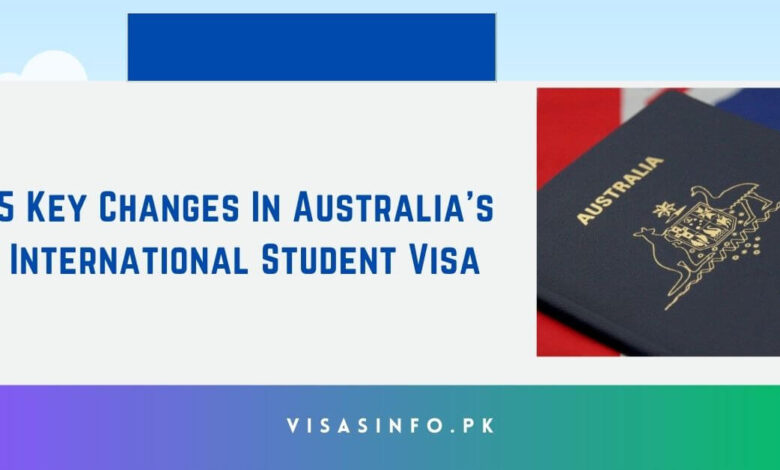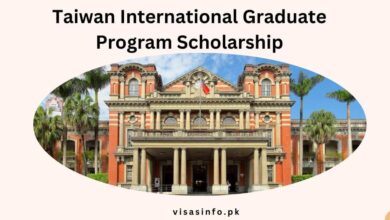5 Key Changes In Australia International Student Visa

This article emphasizes the five most consequential modifications to Australia’s foreign student visa regulations. Continue reading to discover the potential effects of these modifications on the processing of your application. Australia is the optimal environment for international students to pursue their education. Are your objectives identical to mine?
By instituting significant legislative modifications to its international student visa program, Australia has fortified its status as a premier global education destination. The primary objective of these revisions is to enhance the quality of education and the welfare of students. From the middle of 2024, Australia will impose restrictions on the employment opportunities of international students upon their graduation by imposing restrictions on Australian student visa categories.
Therefore, this proposal advocates for the utilization of visas for educational purposes rather than long-term residency. In response to a significant 510,000 migrant inflow during 2022–2023, Australia has resolved to reduce its immigration intake by half through the implementation of a policy change in December.
Furthermore, the Department of Education and the Department of Home Affairs of Australia have announced five substantial modifications to the country’s foreign student visa regulations. We should conduct a more thorough examination of them.
1. Increased Proof of Funds
A more robust financial evidence serves as the initial substantial modification. The previous minimum requirement for applicants to demonstrate savings of 2,455 Australian dollars has been increased by 17% to obtain an Australian student visa. This minimum reserve requirement was implemented by the Australian government on October 1, 2023.
2. Genuine Student Test (GST)
The second modification entails the substitution of the prior authentic temporary admission criteria with an exhaustive examination. The Genuine Student Test (GST) is intended to ascertain whether an applicant has a sincere aspiration to pursue a degree in Australia.
To promote the expansion of the Australian economy and to prioritize candidates who are dedicated to pursuing education over employment, the Australian government implemented this examination in November of the previous year. Consequently, students who pursue certifications at a lower level are at a higher risk of having their visas denied.
3. Higher ASILE Score
Another substantial modification is an increase in the ASILE score. The minimum English language requirement for undergraduate programs has been raised from ASILE 5.5 to 6.0, while the minimum English language requirement for postgraduate programs, such as Master’s and doctoral degrees, has been raised from ASILE 6.0 to ASILE 6.5.
4. Latest University Ranking
The classification of universities has also transformed. The Australian Department of Home Affairs introduced a new classification system in December that is based on risk levels. Universities are now ranked accordingly. This classification divides colleges into three categories based on the number of prior instances of student violations of visa regulations.
In general, visa applications for institutions in Group 1 will be processed more rapidly than those for universities in Groups 2 and 3, which will have a lengthier visa application process. Additionally, applicants in Groups two and three would be required to submit additional documentation regarding their English language proficiency and financial reserves. Consequently, numerous Australian universities have implemented measures to safeguard their reputation, including contacting prospective students once more or urging them to withdraw their applications.
5. End of Post-Study Work Rights
Finally, post-study employment privileges have been abolished. Starting in mid-year, the government will modify the post-study employment rights of overseas students, restoring them to the two- to three-year period they had previously enjoyed. Nevertheless, the duration of the previous extension varied from four to six years, contingent upon the academic level of the international students.
Last month, the Australian Department of Education announced that the duration of time that international graduates spend living and working in Australia would be diminished.
Check Also: Genuine Student Assessment for Australian Student Visas
Benefits of 5 Key Changes In Australia’s International Student Visa
- Post-Study Work Rights Extension: Australia’s post-study work rights extension enables international graduates to remain in the country for extended periods following the completion of their studies. This affords additional time to acquire valuable work experience, which may result in permanent residency pathways.
- Streamlined Visa Processing: The reduction of tension and uncertainty is a result of the faster receipt of visas by international students, which is enabled by improvements in visa processing times. This promotes Australia as a study destination, thereby bolstering the country’s reputation for efficiency and hospitality.
- Increased Working Hours: International students can support themselves financially by working additional hours while studying. This modification has the potential to reduce the cost of studying in Australia, particularly in regions with high living expenses.
- New Regional Incentives: The distribution of the student population across the country is facilitated by incentives for studying in regional areas, such as additional post-study employment rights or scholarships. This benefits both students and regional communities by providing them with distinctive experiences and enhancing their economies and diversity.
- Enhanced Family Visa Provisions: Australia’s more appealing destination for students with families is now enhanced by changes that facilitate simpler family reunification and provide better work rights for dependents. This improves the overall quality of life for international students, thereby motivating them to select Australia over other countries.
Frequently Asked Questions:
What are the recent changes in the Australian student visa?
The Australian Government announced in June 2024 that, starting in July, visitor visa holders and temporary graduate visa holders will no longer be able to apply for student visas while onshore in Australia.
What are the new student visa rules for Australia?
Under the new regulations, visitors, temporary graduate visa holders, and other specified visa holders currently in Australia are not eligible to apply for student visas. However, these new rules will not affect student visa applications submitted within Australia before July 1, 2024.
What is GTE in Australia?
The Genuine Temporary Entrant (GTE) requirement is one of the most important requirements for Australian student visas. The design of this requirement ensures that students who come to Australia for study genuinely intend to return to their home country after their studies are complete.



